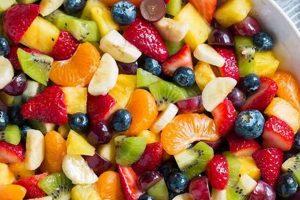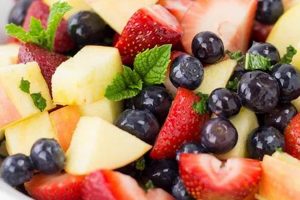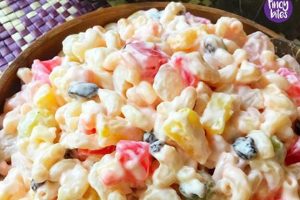Fresh fruit combinations served during the Easter holiday often incorporate seasonal produce like berries, melons, and citrus fruits. These dishes can range from simple mixtures with a light dressing to more elaborate creations involving layered components or molded presentations. For instance, a blend of strawberries, blueberries, pineapple, and kiwi, tossed with a honey-lime dressing, exemplifies a typical offering.
Such vibrant, refreshing dishes offer a welcome contrast to richer, heavier Easter fare. They provide essential vitamins and nutrients, aligning with the springtime emphasis on fresh, healthy ingredients. Historically, fruit salads gained popularity as a festive dish with the increased availability of diverse fruits, particularly during celebratory occasions like Easter. They signify new beginnings and the abundance of the season.
The following sections will explore various aspects of creating these springtime delights, from selecting optimal ingredients to preparing dressings and achieving visually appealing presentations. Specific recipes will cater to diverse palates and dietary needs.
Tips for Creating Exceptional Fruit Salads
Achieving a well-balanced and flavorful fruit salad requires attention to detail throughout the preparation process. The following tips offer guidance for optimal results.
Tip 1: Select ripe, but firm fruit. Peak ripeness ensures optimal flavor and sweetness, while firmness maintains the fruit’s integrity during mixing and serving.
Tip 2: Incorporate a variety of textures and flavors. Combining different fruit types, such as soft berries with crisp apples or melons, creates a more engaging culinary experience. Consider incorporating contrasting flavors, like tart citrus with sweet grapes.
Tip 3: Prepare fruit close to serving time. This prevents oxidation and maintains the fruit’s vibrant appearance and fresh taste. If advance preparation is necessary, store cut fruit in airtight containers with a squeeze of lemon juice to minimize browning.
Tip 4: Use a gentle hand when mixing. Tossing the fruit delicately avoids bruising or crushing more delicate pieces.
Tip 5: Dress the salad judiciously. A light dressing enhances the natural flavors of the fruit without overpowering them. Simple options like a honey-citrus vinaigrette or a light dusting of powdered sugar often suffice.
Tip 6: Consider adding complementary ingredients. Toasted nuts, shredded coconut, or fresh herbs like mint can add textural and flavor complexity.
Tip 7: Pay attention to presentation. A visually appealing arrangement enhances the dining experience. Consider using a variety of colors and shapes, and arrange the fruit attractively in a serving bowl or individual portions.
By following these guidelines, one can create flavorful and visually appealing fruit salads suitable for any occasion.
The following section will delve into specific recipe examples, providing detailed instructions for creating a range of delicious fruit salad variations.
1. Fresh, Seasonal Ingredients
Emphasis on fresh, seasonal ingredients significantly elevates Easter fruit salad recipes. Seasonality dictates optimal ripeness and peak flavor, contributing to a superior culinary experience. Utilizing readily available produce also aligns with traditional springtime celebrations of renewal and abundance.
- Availability and Flavor:
Seasonal fruits offer the most intense flavors due to optimal growing conditions. During spring, ingredients like strawberries, raspberries, and rhubarb reach peak ripeness, providing a naturally sweet and vibrant taste profile ideal for fruit salads. Utilizing in-season produce also supports local agriculture and reduces environmental impact.
- Nutritional Value:
Fruits harvested at their peak ripeness generally offer higher concentrations of vitamins and antioxidants. Incorporating these nutrient-rich ingredients into Easter celebrations provides health benefits alongside culinary enjoyment. Fresh fruit contributes vital nutrients often absent in other holiday fare.
- Visual Appeal:
The vibrant colors of seasonal spring fruits enhance the visual appeal of Easter fruit salads. The bright hues of berries, melons, and citrus fruits create an attractive presentation, reflecting the festive nature of the holiday. This visual element adds to the overall dining experience.
- Recipe Adaptability:
The availability of specific seasonal ingredients allows for recipe adaptation and creativity. Springtime produce lends itself to various preparations, from simple macerations to more complex layered desserts. This flexibility allows for customization based on individual preferences and dietary needs.
By prioritizing fresh, seasonal ingredients, Easter fruit salads transform into vibrant, flavorful, and nutritious dishes that embody the essence of springtime celebrations. The connection between seasonality and recipe development ensures a truly memorable and enjoyable culinary experience.
2. Complementary Flavor Profiles
Flavor balance forms the foundation of successful Easter fruit salad recipes. Strategic combinations of sweet, tart, and acidic fruits elevate the dish beyond a simple mixture of ingredients, creating a complex and enjoyable sensory experience. Understanding these flavor dynamics allows for thoughtful recipe development and ingredient selection.
- Balancing Sweetness and Acidity:
Pairing inherently sweet fruits like berries and melons with acidic counterparts such as citrus fruits or tart apples creates a balanced flavor profile. The sweetness is tempered by the tartness, preventing the salad from becoming overly sugary. For example, incorporating segments of grapefruit or orange alongside strawberries and blueberries offers a refreshing contrast.
- Incorporating Herbs and Spices:
Fresh herbs like mint or basil, or spices like cinnamon or ginger, can introduce additional layers of flavor complexity. Mint complements melons and berries, while a hint of cinnamon enhances the sweetness of apples and pears. These additions provide subtle aromatic notes that elevate the overall taste experience.
- Textural Contrast and Flavor Enhancement:
Varying textures within the salad contribute not only to visual appeal but also enhance flavor perception. Crisp apples or firm grapes alongside softer fruits like kiwi or mango provide textural contrast, creating a more dynamic eating experience. This interplay of textures further accentuates the individual flavors of each fruit.
- The Role of Dressings:
Dressings further enhance complementary flavor profiles. A light vinaigrette with citrus juice and honey can brighten the fruit flavors without masking their natural sweetness. Alternatively, a creamy yogurt-based dressing adds a tangy element that complements tropical fruits like pineapple and mango. The choice of dressing should harmonize with the chosen fruit combination.
Careful consideration of complementary flavor profiles elevates Easter fruit salads from simple mixtures to sophisticated culinary creations. By understanding these flavor interactions, one can craft a dish that offers a balanced, refreshing, and memorable taste experience, reflecting the essence of springtime celebrations.
3. Varied Textures and Colors
Visual appeal plays a significant role in culinary enjoyment. Varied textures and colors contribute substantially to the aesthetic presentation of Easter fruit salads, enhancing the overall dining experience. This visual dimension complements the flavor profile, creating a dish that is both delicious and attractive.
Textural diversity, achieved through incorporating fruits with different consistencies, offers a more engaging sensory experience. Combining elements such as the smooth texture of sliced bananas with the crispness of diced apples or the firmness of grapes introduces a dynamic interplay that elevates the salad beyond a homogenous mixture. The contrast in textures stimulates the palate and enhances the perception of individual flavors. For instance, the juicy burst of a grape contrasts delightfully with the crunch of an apple, creating a more complex and satisfying culinary experience.
Color variation further amplifies the visual appeal. The vibrant hues of spring fruits, such as the deep reds of strawberries, the bright oranges of segments of mandarin, and the verdant greens of kiwi, create a visually stimulating presentation. This vibrancy reflects the celebratory nature of Easter and the renewal associated with springtime. A thoughtfully arranged fruit salad, showcasing a spectrum of colors, becomes a centerpiece that enhances the festive atmosphere. The strategic placement of contrasting colors, like a ring of red raspberries around a center of golden pineapple chunks, maximizes visual impact.
Achieving this balance requires careful ingredient selection. Consider not only the flavor profiles but also the colors and textures each fruit contributes. A monochromatic salad, while potentially flavorful, lacks the visual interest generated by a diverse palette. Similarly, a salad composed solely of soft fruits lacks the textural contrast that elevates the eating experience. Thoughtful planning ensures a harmonious blend of flavors, textures, and colors, culminating in a dish that is both visually appealing and gastronomically satisfying. This attention to detail transforms a simple fruit salad into a culinary centerpiece worthy of an Easter celebration.
4. Appropriate Dressings/Sauces
Dressings and sauces play a crucial role in Easter fruit salad recipes, enhancing flavor profiles and contributing to the overall culinary experience. The appropriate choice complements the natural sweetness and textures of the fruit, creating a harmonious balance rather than masking the delicate flavors. Careful selection ensures the dressing enhances, rather than dominates, the inherent qualities of the fruit.
- Light Vinaigrettes:
Citrus-based vinaigrettes, often incorporating lemon, lime, or orange juice, provide a bright, acidic counterpoint to the sweetness of the fruit. A touch of honey or maple syrup adds a subtle sweetness, balancing the tartness. These light vinaigrettes work particularly well with berries, melons, and stone fruits, enhancing their natural flavors without overpowering them. For example, a lime-mint vinaigrette complements a melon and berry salad, while a lemon-poppy seed vinaigrette enhances a mix of grapes and citrus segments.
- Creamy Dressings:
Yogurt-based dressings offer a creamy texture and a tangy flavor that complements tropical fruits like pineapple, mango, and papaya. Greek yogurt provides a thicker consistency and a higher protein content, while coconut yogurt offers a richer, more decadent option. These creamy dressings can be flavored with vanilla, honey, or spices like ginger or cardamom to further enhance the flavor profile. A vanilla-yogurt dressing pairs well with a mixed berry salad, while a coconut-lime dressing complements a tropical fruit medley.
- Simple Syrups and Glazes:
A light drizzle of simple syrup, infused with herbs like mint or basil, adds a touch of sweetness and aromatic complexity. Alternatively, a fruit glaze, made by reducing fruit juice with a touch of sugar, provides a concentrated burst of flavor. These options work well with salads featuring firmer fruits like apples, pears, and grapes. A mint-infused simple syrup complements a melon and berry salad, while a raspberry glaze enhances a mix of apples and pears.
- Dustings and Toppings:
A light dusting of powdered sugar or a sprinkle of shredded coconut adds a touch of sweetness and textural contrast without adding significant moisture. Toasted nuts or seeds, such as slivered almonds or pumpkin seeds, provide a crunchy element and enhance the nutritional value. These options offer a simple yet effective way to enhance the presentation and flavor profile of the salad. A dusting of powdered sugar complements a mixed berry salad, while toasted almonds enhance a fruit salad with apples and grapes.
The choice of dressing or sauce depends on the specific combination of fruits in the Easter fruit salad recipe. Consider the flavor profiles, textures, and desired overall balance when selecting the appropriate complement. A well-chosen dressing enhances the natural sweetness and flavors of the fruit, creating a harmonious and refreshing dish perfect for springtime celebrations.
5. Attractive Presentation Styles
Presentation elevates Easter fruit salad from a simple dish to a centerpiece, reflecting the celebratory spirit of the occasion. Visual appeal enhances perceived flavor and enjoyment. Consideration of color, texture, and serving vessel contributes significantly to the overall presentation.
A vibrant color palette achieved through varied fruit selection creates immediate visual interest. Strategic arrangement amplifies this effect. Contrasting colors, such as red strawberries against green kiwi, create focal points. Textural variation, incorporating both smooth and crisp elements, adds another dimension. A combination of sliced bananas, segmented oranges, and whole blueberries offers a dynamic visual and textural experience. The serving vessel further influences presentation. A clear glass bowl showcases the vibrant colors, while individual serving glasses or hollowed-out fruit shells add a touch of elegance. Garnishes, such as fresh mint sprigs or edible flowers, provide finishing touches.
Practical application of these principles transforms the fruit salad. A simple arrangement might involve layering colorful fruits in a trifle bowl. A more elaborate presentation could involve carving a watermelon into a basket shape and filling it with the fruit salad. The choice depends on the occasion and desired level of formality. Skillful presentation transforms a basic fruit salad into a visually appealing and memorable element of the Easter celebration, enhancing both the perceived flavor and overall dining experience. Attention to detail in presentation reflects care and consideration, adding value beyond the ingredients themselves.
Frequently Asked Questions
This section addresses common inquiries regarding the preparation and presentation of fruit salads suitable for Easter celebrations.
Question 1: How can browning of cut fruit be prevented?
Fruit browning results from oxidation. Minimizing exposure to air and applying an acidic agent, such as lemon or pineapple juice, helps prevent this process. Storing cut fruit in airtight containers in the refrigerator also delays browning.
Question 2: What are suitable dressings beyond traditional vinaigrettes?
Alternatives include citrus-infused honey, light maple syrups, or yogurt-based dressings. Consider flavor pairings; for example, a honey-lime dressing complements tropical fruits, while a vanilla yogurt dressing enhances berries.
Question 3: Can fruit salads be prepared in advance for Easter gatherings?
Advance preparation is possible, but best practices involve preparing components separately. Combine ingredients close to serving time to maintain optimal freshness and prevent undesirable textural changes. Store cut fruit separately and combine just before serving.
Question 4: How can one ensure a balanced flavor profile in a fruit salad?
Balance sweetness with acidity. Incorporate tart fruits like citrus segments or cranberries alongside sweeter options like berries or melons. A judicious use of dressing further enhances flavor balance.
Question 5: What fruits are typically in season during Easter?
Spring fruits like strawberries, raspberries, blueberries, kiwi, and early-season stone fruits like apricots and cherries are often readily available and offer vibrant flavors suitable for Easter celebrations. Availability varies by region.
Question 6: How can presentation be enhanced beyond simply placing fruit in a bowl?
Consider using individual serving dishes, hollowed-out fruit halves, or creating layered presentations in clear glass bowls. Garnishes like fresh mint sprigs, edible flowers, or a dusting of powdered sugar add visual appeal.
By addressing these common questions, individuals can approach fruit salad preparation for Easter gatherings with greater confidence, ensuring both a flavorful and visually appealing contribution to the celebratory meal.
The following section will offer a curated selection of specific Easter fruit salad recipes incorporating the principles discussed throughout this article.
Easter Fruit Salad Recipes
Exploration of Easter fruit salad recipes reveals the potential for culinary creativity and festive presentation. Emphasis on fresh, seasonal ingredients, balanced flavor profiles, varied textures, and complementary dressings elevates these dishes beyond simple fruit mixtures. Strategic presentation further enhances the dining experience, transforming the fruit salad into a celebratory centerpiece.
Thoughtful consideration of these elements allows adaptation and personalization of recipes to suit individual preferences and dietary needs. Easter fruit salad recipes offer a refreshing and nutritious complement to traditional holiday fare, signifying the vibrancy and renewal associated with springtime. Culinary exploration of these recipes enriches the celebration and fosters a deeper appreciation for the versatility and potential of fresh, seasonal produce.






